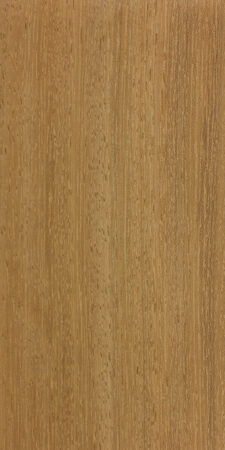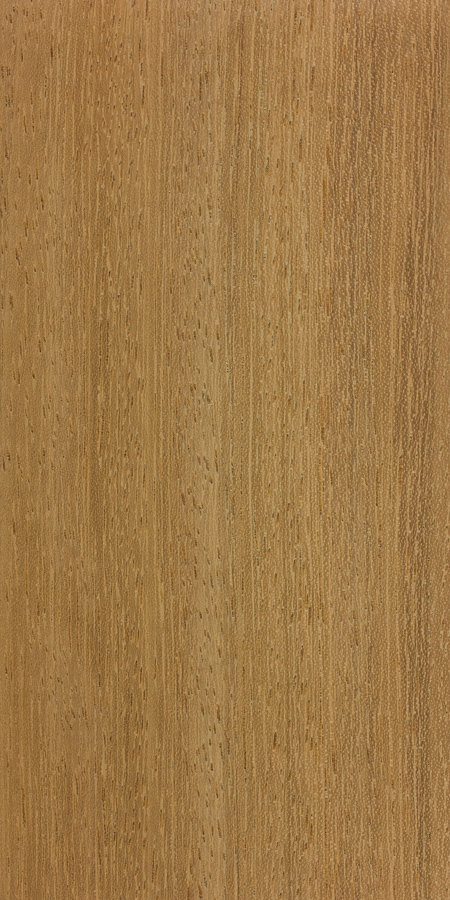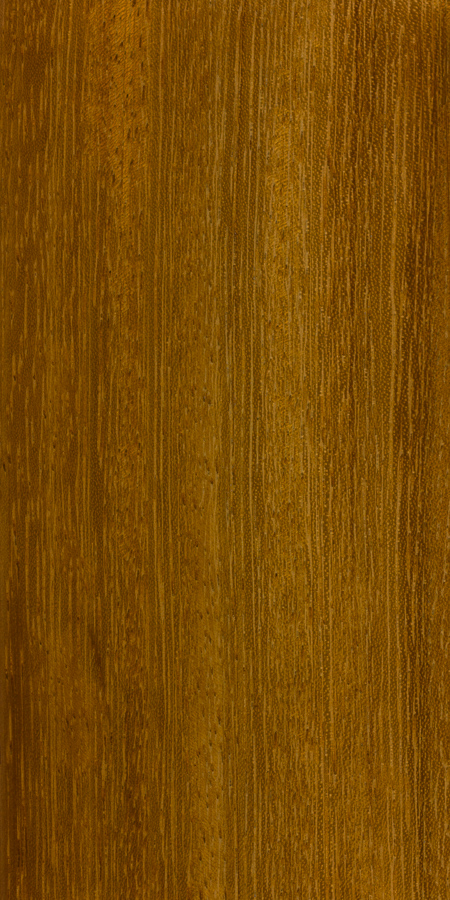Iroko | The Wood Database (Hardwood) (original) (raw)
Iroko (Milicia excelsa)
Common Name(s): Iroko, African teak
Scientific Name: Milicia excelsa and M. regia (formerly placed in the Chlorophora genus, see comments below)
Distribution: Tropical Africa
Tree Size: 100-130 ft (30-40 m) tall,
3-5 ft (1-1.5 m) trunk diameter
Average Dried Weight: 41.2 lbs/ft3 (660 kg/m3)
Specific Gravity (Basic, 12% MC): 0.56, 0.66
Janka Hardness: 1,190 lbf (5,310 N)
Modulus of Rupture: 14,080 lbf/in2 (97.1 MPa)
Elastic Modulus: 1,580,000 lbf/in2 (10.90 GPa)
Crushing Strength: 7,750 lbf/in2 (53.5 MPa)
Shrinkage: Radial: 3.3%, Tangential: 4.8%,
Volumetric: 8.8%, T/R Ratio: 1.5
Color/Appearance: Heartwood is usually a yellow to golden or medium brown, with color tending to darken over time. Pale yellow sapwood is clearly demarcated from the heartwood.
Grain/Texture: Grain is interlocked and sometimes irregular; medium to coarse texture with good natural luster. Unfinished wood surfaces can feel greasy/oily to the touch.
Rot Resistance: Iroko is very durable, and is resistant to both rot and insect attack; it’s sometimes used as a substitute for genuine teak (Tectona grandis).
Workability: Generally easy to work, with the exception of its interlocked grain, which may cause some tearout during surfacing operations. Also, deposits of calcium carbonate are sometimes present, which can have a significant dulling effect on cutters. Iroko glues and finishes well.
Odor: No characteristic odor.
Allergies/Toxicity: Although severe reactions are quite uncommon, iroko has been reported as a sensitizer. Usually most common reactions simply include eye, skin, and respiratory irritation. Iroko can also cause other health effects in sensitive individuals, such as asthma-like symptoms, boils, and hypersensitivity pneumonitis. See the articles Wood Allergies and Toxicity and Wood Dust Safety for more information.
Pricing/Availability: Iroko is imported and available for a moderate price. Veneer can also be seen for sale, and is likewise affordably priced.
Sustainability: This wood species is not listed in the CITES Appendices, but is on the IUCN Red List. While Milicia excelsa is only listed as near threatened, M. regia is listed as vulnerable due to a population reduction of over 20% in the past three generations, caused by a decline in its natural range, and exploitation.
Common Uses: Veneer, flooring, furniture, cabinetry, boatbuilding, turned items, and other small specialty wood items.
Comments: Although the Milicia genus was first described back in 1909,[1]Sim, T. R. (1909) Forest Flora and Forest Researches of Portuguese East Africa: 97 for many decades iroko was placed in the Chlorophora genus, along with osage orange (as C. pomifera) and fustic (as C. tinctoria) —though these species are now placed in the Maclura genus. However, the Milicia genus was reinstated back in 1982,[2]Berg, C. C. (1982). The reinstatement of the genus Milicia Sim (Moraceae). Bulletin du Jardin botanique national de Belgique/Bulletin van de Nationale Plantentuin van Belgie, 225-229. with two recognized species (M. excelsa and M. regia). Both Milicia species are sold commercially as iroko, though M. excelsa is much more widespread and common throughout tropical Africa, with M. regia being restricted to a narrower region of forest areas within West Africa.
Iroko is sometimes marketed as a low-cost alternative to genuine teak, and is even sold under the name African teak, though that common name is much more commonly applied to afrormosia (Pericopsis elata)—but neither of these woods are botanically related to true teak. Nonetheless, the wood is stable, durable, and has an overall look that somewhat resembles teak.
Images: Drag the slider up/down to toggle between raw and finished wood.
A special thanks to Justin Holden for providing a wood sample, and also to Steve Earis for providing a wood sample and turned photos of this wood species.
Porosity: diffuse porous; growth rings indistinct
Arrangement: solitary and radial multiples
Vessels: large to very large, few to very few; tyloses common
Parenchyma: vasicentric, winged, lozenge, confluent, and banded
Rays: medium to wide width, normal spacing; rays may be just barely visible without magnification
Lookalikes/Substitutes: Afrormosia (Pericopsis elata) is another African hardwood that can bear a very close similarity to iroko and is also marketed as African teak. However, on average, afrormosia tends to have smaller, more numerous pores, and narrower rays.
Notes: None.
The Milicia genus contains only two species, M. excelsa and M. regia, both of which are sold interchangebly as iroko.


